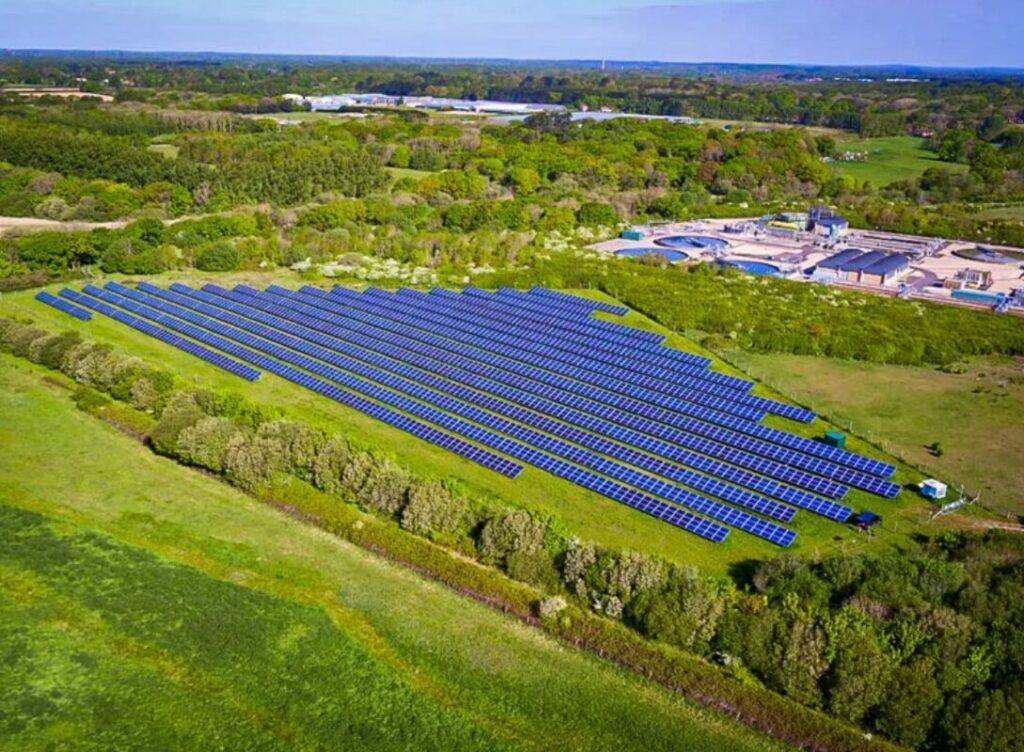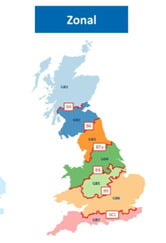
The Department for Energy Security and Net Zero (DESNZ) opened a second consultation for the Review of Electricity Market Arrangements (REMA) yesterday (12 March), with zonal pricing put forward for further exploration.
This confirms reports circulating earlier this week that DESNZ is looking to move away from a uniform price across markets towards stronger locational signals in Britain’s wholesale market to incentivise the development of renewable assets around cities so that densely populated areas can access cheaper renewable electricity.

A zonal market splits electricity prices across a few large regions – as illustrated in an example previously produced by management consultancy FTI Consulting and market researcher Energy Systems Catapult – all consumers within a defined zone or region are then charged the same price.
According to FTI Consulting and Energy Systems Catapult’s aforementioned report, commissioned by Ofgem, consumer savings could range between £15 billion and £31 billion between 2025 and 2040 if a zonal market mechanism was implemented.
The government commissioned its own report through accounting firm Grant Thornton and business management consultant LCP Delta to assess the impacts of alternative locational investment and operational signals under locational pricing.
For this study, the nation was split into 12 zones that “capture the key transmission network boundaries used”.
According to the report, under DESNZ’s net zero higher demand scenario, where annual electricity demand levels reach 700TWh by 2050, a locational pricing mechanism would decrease Britain’s electricity system costs by £5 billion (Net Present Value in 2022 real prices) between 2030 and 2050 “with redispatch inefficiencies in the national pricing counterfactual removed and £15bn where redispatch inefficiencies are assumed in the national pricing counterfactual”.
Consumers would see a significant reduction in their costs under a zonal pricing mechanism, as the study estimated a reduction of £24 billion and £59 billion for the higher demand and lower demand, reaching 525TWh by 2050, net zero scenarios. This, however, would result in a £19 billion and £44 billion producer cost increase, respectively.
A “system benefit” for the UK
“This shows a system benefit from moving to locational pricing with costs transferred from producers to consumers,” wrote DESNZ in the ‘System Benefits from Efficient Locational Signals’ research paper, published today.
“The drivers of these benefits are split into two types: investment efficiency, where more efficient locational signals cause plants to locate in areas more beneficial to the system, and operational efficiency, where cost savings are a result of changes in the operation of the market (regardless of plants changing location).”
Additionally, zonal pricing is well-precedented, as it is already in place in European countries such as Italy and Sweden.
“It is increasingly clear that the only way we can get to a net zero electricity system in time and without pushing up bills is to move to a market that reflects local supply and demand,” said Guy Newey, CEO at Energy Systems Catapult.
“It is an essential step forward to see government proposing stronger locational signals in the wholesale market through zonal pricing and a strong push for a smarter energy system.”
Newey also expressed his disappointment in seeing nodal pricing ruled out as “improved locational signals will deliver significant benefits to consumers and opportunities for innovators”.
Nodal pricing was the second locational pricing mechanism considered as part of Britain’s Review of Electricity Market Arrangements (REMA). It would determine market prices on a much more micro-level, according to roughly 850 areas on the transmission grid called ‘nodes’, each with an individual price.
However, the complexity of the mechanism would require much more time to implement, causing more upheaval than a zonal market would, a point noted by a number of respondents in the REMA consultation.
Solar industry warns of market uncertainty
“In theory, [zonal pricing] should incentivise generation to locate close to demand and alleviate constraints on the transmission grid,” wrote Solar Energy UK and RenewableUK in a joint response to yesterday’s announcement.
However the associations worry that it could introduce “additional uncertainty into the market,” which will raise the cost of capital for renewable energy.
“Although it is positive to see that this consultation now discards the earlier option of moving to a nodal pricing system (with the price set at hundreds of nodes across the transmission system), we remain sceptical about the claimed benefits of a zonal system,” added the associations.
Ana Musat, executive director for policy and engagement at RenewableUK added: “Consulting on the best arrangements to underpin our future electricity markets is essential given the levels of system transformation we have seen just in the last decade.
“We are glad to see the REMA consultation move away from the concept of nodal pricing, which would have been lengthy and expensive to implement and would have provided a disincentive to investment in renewable generation.
“The consultation is still inviting views on whether zonal pricing can be feasibly introduced while maintaining investor certainty. However, given stronger locational constraints faced by projects – such as planning hurdles, including a de-facto ban on onshore wind in England or grid connections, the influence of zonal pricing on location choices will likely be limited.”
The second REMA consultation opens
Yesterday’s announcement marks the opening of the second REMA consultation, which will run until 7 May 2024 and will seek views on a narrow range of electricity market framework delivery options.
Within the consultation document, the government confirmed that nodal pricing has been discounted as a viable option for Britain.
Government proposals also include retaining an updated Capacity Market with the bolstered participation of low-carbon technologies and continuing the Contracts for Difference (CfD) model.
This follows the launch of the Spring Budget last week, which confirmed that the budget for the latest CfD auction round (AR6) will surpass £1 billion.
“We need urgent action to ensure energy security in a future net zero system. Well-designed market reform and accelerated network build would mean renewable electricity can meet more of our needs more often. The final few hours of energy demand each year will always be the hardest to decarbonise,” said Dan Monzani, managing director UK & Ireland at Aurora Energy Research.
“So we need to double down on firm low carbon technologies, like nuclear, carbon capture and long-duration storage but we also need to invest in maintaining reserve gas capacity. In a net zero system in 2035, we will need to run gas 90% less often but we still need to maintain two-thirds of the current gas capacity to ensure our energy needs are met at all times.”
Part of this article was taken from a piece published on our sister site Current±.

